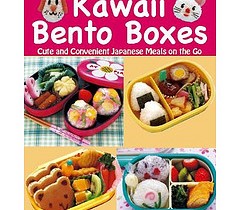Book Review: Kawaii Bento Boxes
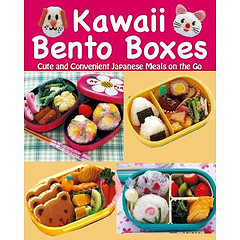 There aren’t many bento cookbooks written in English, so of course I’m curious when a new one comes out. I’m a big fan of Japanese-language cookbooks for their glanceable step-by-step photos and intuitive graphic presentation of complex material. Kawaii Bento Boxes: Cute and Convenient Japanese Meals on the Go, newly published by Japan Publications Trading’s Boutique-Sha, really captures the essence of fun, kids-oriented Japanese bento cookbooks.
There aren’t many bento cookbooks written in English, so of course I’m curious when a new one comes out. I’m a big fan of Japanese-language cookbooks for their glanceable step-by-step photos and intuitive graphic presentation of complex material. Kawaii Bento Boxes: Cute and Convenient Japanese Meals on the Go, newly published by Japan Publications Trading’s Boutique-Sha, really captures the essence of fun, kids-oriented Japanese bento cookbooks.
As I was leafing through it, though, something started to seem oddly familiar. A quick browse through my kitchen bookshelf revealed why I was experiencing deja vu: it’s a straight translation of the same publisher’s Japanese-language cookbook Ichinenju Yakudatsu Tsuen Obento: Daisukina Kondate ga Ippai: (“Children’s Bentos that are Helpful Year-round: Lots of Favorite Menus”), with identical photos, layout, and text.
Now, there are both good and bad aspects to a straight translation of a bento cookbook written for the Japanese market. It’s extremely well suited for bento enthusiasts or Japanophiles already familiar with Japanese food, but may miss the mark for others…
Like Hawaii’s Bento Box Cookbook (see my full review here), Kawaii Bento Boxes is aimed at parents of young children who want to add playfulness to packed lunches, with simple recipes for very Japanese bentos that can be prepared in 20 minutes or less. You can browse the inside of the book at Amazon, and view the full table of contents and sample pages. The US$18.95 book (currently $12.89 on Amazon) is 82 pages long and in soft-cover magazine-book (“mook”) format.
1. The Book Structure
Kawaii Bento Boxes opens with some brief but solid introductory material about bento basics, including an overview of bento gear and how to pack a bento (browsable in full on Amazon).
Most of the book consists of photos of cute sample lunches with short recipes and a time estimate of how long it will take to prepare the bento (usually 15-20 minutes, assuming you’ve got staples like cooked rice already made, fresh or frozen). Every other page has an abbreviated step-by-step tutorial with photos, like the section on how to make rolled pancakes below (very helpful). These lunches are further divided into types, such as rice, sushi, bread, pasta, warm-weather, cold-weather, favorites, and picnic bentos. Here’s the pancake page:
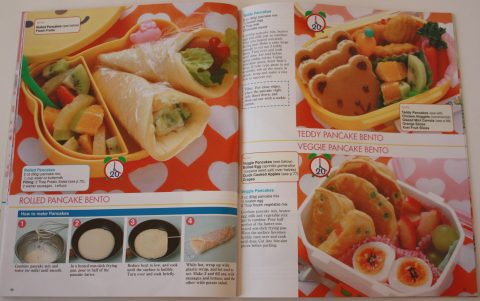
Throughout the book are a number of sections showing variations on a theme, that may inspire readers to think outside the box with their own creations. Here’s a page with differently decorated onigiri rice balls (see below) and a sample lunch.
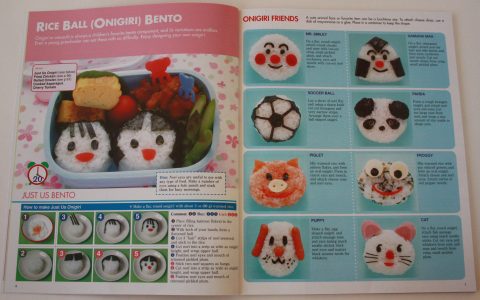
Here’s the same page in the Japanese original, so you can see they’re identical.
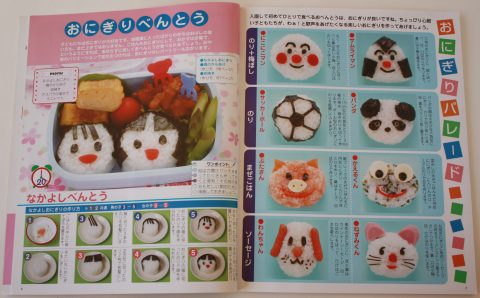
And a few pages of food art accents made with eggs, sausages, fruits and vegetables.
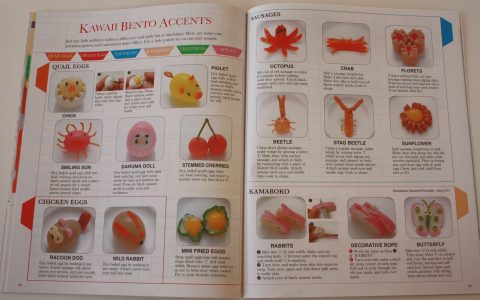
Note the classic apple rabbits! (See my apple rabbit tutorial for detailed directions.)
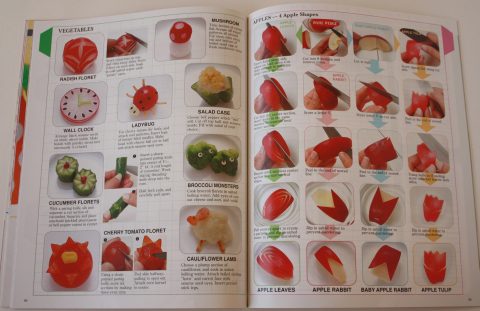
At the end of the book is a visual, color-coded index of additional recipes, organized by the main color of the dish: brown/black, white, yellow, red, or green. This makes sense when you think of the five-color rule of thumb for bento composition. You know how a colorful meal is a healthy meal? Including a variety of different colored foods in a bento helps ensure a balance of nutrients, so it’s handy to have a glanceable index of recipes sorted by color. Staring into the fridge and can’t think of, say, a red/orange dish? Leaf through some cookbooks organized like this and you might get some quick ideas.
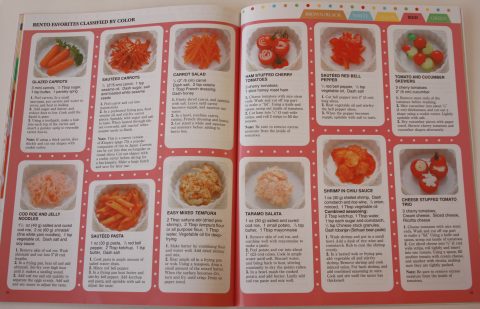
2. The Nitty Gritty
My main hesitation about recommending this book for everyone is the food itself and the lack of background information for those unfamiliar with the ins and outs of Japanese food. It includes unusual ingredients that may not appeal to the average American child, like gobo (burdock root), natto (fermented soy beans), ume (sour plum), and eel.
To get some perspective, I showed this book to a couple of mom friends (American and English) who pack lunches for their kindergarten-aged children. Their take was that they might use it for inspiration and general ideas for ways to pack bentos and what to include, but that it looks time-consuming so they’d probably apply their own food. The dishes seemed unusual to them and geared toward a Japanese audience (yakisoba sandwich, anyone?), and they didn’t always understand what some of the bento accessories like sauce containers were, mistaking them for actual food. Japanese readers wouldn’t necessarily need an explanation, but non-Japanese would definitely benefit from more background information or the inclusion of slightly different dishes that are more common here.
Overall, Kawaii Bento Boxes is quite professionally done, but with some omissions that may make it a little confusing to a Western audience looking to quickly prepare recipes with ingredients already in the kitchen. Look at it as inspiration, though, and you’ll come away with a lot of fresh new ideas for lunches you’d like to prepare using foods your family already enjoys.
If you’re already familiar with bento lunches and Japanese food, however, I think you’ll really enjoy this little gem. The Japanese version has been one of my favorites for a while now, so I’m pleased that it’s now accessible to English-readers.
FURTHER READING:

